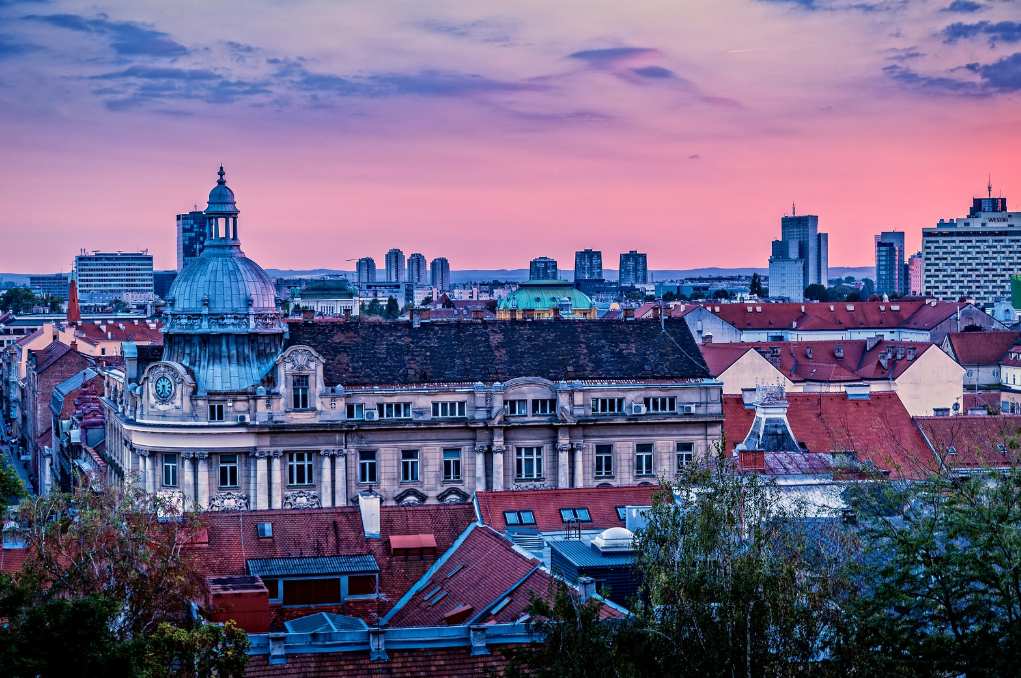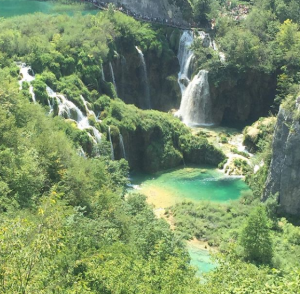Although Croatia is not a large country, it is a land that is Mediterranean, Central European, mountainous and flat, coastal and continental. It can therefore be safely said that Croatia is characterized by a diversity and wealth of nature seen in much larger European countries; that is to say, within a relatively small area are landscapes that otherwise one would have to seek in widely spaced parts of Europe, and indeed the world.
Which is why Croatia ranks as one of the top five European countries with regard to biodiversity, with some parts being among the world’s richest such areas. Thus, in Croatia we have a richly indented wooded shore line, with numerous islands, as in the Southern Seas, preserved old Mediterranean towns with stone-built houses and narrow streets, as in Italy, but also green coastal meadows with dry stone walls that seem to have been transposed from Ireland.
The mountainous areas abound in wide expanses of woods and forests, as in Scandinavia, romantic lakes, rushing rivers and settlements, as in the Alps, as well as harsh and barren karstic landscapes with deep gorges and canyons, like those in the “Wild West” of the USA. In the wide plains of lowland Croatia there still exist preserved wetland areas otherwise found only in the easternmost parts of Europe, in Russia or Ukraine, while the country’s mellow, gently undulating areas are decked with vineyards, medieval castles, burgs and fortresses the likes of which are seen in Germany and Austria.The most treasured parts of Croatia’s natural heritage comprise 447 different protected areas covering a total of 5,178 km2, i.e. about 10% of Croatia’s land area.
The most important among those areas are eight national parks (Plitvice Lakes, the River Krka, the Kornati Archipelago, the island of Mljet, Northern Velebit, Paklenica and Risnjak); eleven nature parks (Kopacki rit, Papuk, Lonjsko polje, Medvednica, Zumberak, Samoborsko gorje, Ucka, Velebit, Telascica, Vransko jezero, Biokovo and the Lastovo islands); and two strict regime reserves (Bijele and Samarske stijene, on Bjelolasica, and Rozanski and Hajducki kukovi, on Velebit).
In addition to national parks, nature parks and strict regime reserves, Croatia has another 426 different smaller areas and objects under protection. Of those, 78 are special reserves (botanical, wooded/forested, geomorphological, hydrological, ichtyological, ornithological, maritime and zoological); 38 are park woods; 71 are classified as outstanding landscapes, and 104 are natural monuments (geological, geomorphological, palaeontological, and rare examples of trees).
Special protection has also been extended to more than 135 monuments of park architecture: arboretums, botanical gardens, parks, individual trees and groups of trees. A total of 846 animal species have been placed under protection (including 339 birds and 74 mammals), 809 plants species and 314 types of mushroom.The three main natural entities of Croatia: flat,mountainous and coastal, are fundamentally different in their main characteristics. The largest of these areas comprises fertile and well populated lowland Croatia, which occupies the south-western edge of the vast Pannonian Plain. Its main natural characteristics are the centuries-old oak forests of the diluvial plains, numerous rivers, their original courses preserved, and an abundant plant and animal world on land, in the waters and in the air. However, although located within Panonian Plain this region is not always uniformly flat.
Rising along the horizons of the fields and meadows are the wine growing hill slopes and wooded elevations of Pannonia which, like islands, rise above the sea of wheat.In contrast to the lowlands, mountainous Croatia is small and very sparsely populated, which explains why it has been so well preserved in its original state. Its dense forests of beech, pine and spruce are the domain of bears, wolves and lynx, while its sparkling clean and clear rivers are ruled by otters and trout. The heights reached by Croatian mountains may not be those of Alps, but the shapes of white limestone are often such that they can be an inspiration to even the most imaginative of sculptors, this thanks to the wide range of karstic phenomena within the limestone composition of rocks so specifically typical of Croatia.

The wealth of karstic forms: fissures, sink holes found on the surface continues through a subterranean world of caves, caverns, galleries, chasms and other distinctive relief forms not easily found elsewhere in Europe. The significance of the Croatian karst is best seen in the fact that in the technical literature for the majority of these forms, the names of which are difficult to accurately translate, the original Croatian terms are used, for instance: “uvala”, “polje”, “hum”.And finally, the jewel in the crown to all that attracts most visitors to Croatia, her littoral. The Croatian coastline has, alongside the Greek, the largest number of islands and is the most indented in the Mediterranean.
Length of the coastline extends to 1,778 km and, together with the shores of the 1,185 islands, isles, crags and reefs, to an amazing 5,835 km. The number of coves, bays, nooks and crannies, and hidden intricate details along those shores is difficult to comprehend, and all are washed by crystal clear seas and boasting a wide variety of faces: from craggy and harsh rock-bound vegetation. Here, all our visitors, particularly those on their boats or yachts, are able to discover their very own little corner. So now let us set off and get to know the natural beauties of Croatia, and help us to make sure that they remain as they are today for future generations to enjoy.
Vacation in Croatia

Located in the heart of Central Europe, Croatia is one of the most interesting nations in the world. A rather average sized country, yet it has over 1,700 kilometers of magnificent looking coastline and about 1,185 islands that surround it, with only 66 island still inhabited. Croatia borders the country of Slovenia to the north, Italy to its west and from the east and south lies Bosnia and Montenegro.
Croatia is formerly part of the former Yugoslavian country and is now an independent nation. Croatia today is a haven for holiday makers and a great tourist destination for a lot of travelers from around the world.
The capital city of Croatia is Zagreb City; it is a beautiful city that continues to attract vacation seekers from around the world. This is a city that is filled with a lot of historical old buildings and monuments brought on by more than 1,000 years of Croatia’s rich history, with most of the structures were built and designed in the 19th and 20th century during the reigning time of the Austro and Hungarian empire.
The splendid and visual feast of a place in the Croatian Adriatic coast is also one of the top vacation spots in Croatia. It stretches from the Istria, straight towards the northern region of Kvarner and then to Dalmatia and its beautiful pearls Dubrovnik and Split in the southern region. Not to mention the scattered 1,000 islands around Croatia that earns this country the moniker as the 2nd Greece of the Mediterranean region.

The Plitvice lakes national park is another vacation spot in Croatia that attracts tourists all year round. It features stunning and majestic landscape and it’s natural beauty expresses a sense of lavish wonder from any visitors, the great mountain ranges and the scenic green landscape that surrounds the place, crystal clear lake waters all contribute to the over all beauty of the Plitvice lakes national park.
Another great reason why Croatia is a wonderful vacation choice is the people, they are very warm and hospitable and are always kind and nice to travelers of different nationality, vacationing in Croatia will make you feel like you’re not away from your home.
Croatia also gets international recognition in terms of being a great vacation spot, recently the world renowned National Geographic Adventure magazine in its yearly survey form its editors and journalist, Croatia was adjudged as the “2006 Top Vacation Destination in the World”, this is a kind of recognition that makes Croatia as an official top vacation destination among all other nations.
Croatia offers a lot of vacation choices, from backpackers enjoying and learning a different culture aside from their own, honeymooners, retirees’ vacations and even a vacation fit for the whole family. Croatia is becoming one of the top tourist havens in the world, make sure to include this country in every vacation plans that you might make in the near future so you will guarantee yourself a vacation to remember for the rest of your life.
POLITICAL SYSTEM: The Republic of Croatia is a unitary and indivisible democratic and social state.
CAPITAL: Zagreb
LANGUAGE: Croatian
LOCATION
Medium-sized European country consisting of two distinct natural and geographic regions: Geographically and culturally inland (continental) Croatia is part of central Europe while coastal Croatia lies on the Mediterranean.
The Pannonian region covers about 55% of the country’, the coastal area covers about 31% and the mountains covers only about 14%.
AREA
Land – 56,610 km2 (65% of total)
Coastal sea – 31,067 km2 (35% of total)
Total – 87,677 km2 (100%)
By its continental area, Croatia is a middle-sized European country and is ranked 25th in Europe. By its overall continental area and territorial sea, Croatia ranks 20th in Europe.
BORDERS
Continental Croatia has borders (2,028 km) with five countries: Bosnia-Herzegovina – 932 km (46% of the land borders); Slovenia – 501 km (25%); Hungary – 329 km (16%); Serbia – 241 km (12%); Montenegro – 25 km (1%)
Sea borders: Slovenia, Montenegro, Italy
RELIEF
Republic of Croatia is dominated by lowlands, since as much as 52,63% of its area lies at altitudes below 200 meters.
Croatia is part of the more recent formations of the Eurasian relief system of young mountain chains. Velebit is the largest mountain in Croatia, while Dinara is the highest mountain.
CLIMATE
Due to its location in the temperate region of the northern hemisphere, Croatia has a balmy climate with four clearly defined seasons.
THE ADRIATIC SEA
The Adriatic is a large bay of the central Mediterranean, separated from the rest of it by the Apennines.
138,000 km2- 5% of the Mediterranean; temperature – 11C at its lowest point, 22 – 25C at the surface; depth – 1,233 meters; average salinity – 38%
ISLANDS
Croatia has a total of 1,185 islands, rocks and reefs, including 66 unhabited and 652 inhabited islands, as well as 389 rocks and 78 reefs.
DEMOGRAPHICS
According to the 31 March 1991 census, the Republic of Croatia had 4, 784, 265 inhabitants (84.6 inhabitants per square kilometre).
- Population: medium populated European country
- The most populated area: the Central region (Zagreb)
- The least populated area: the mountainous (Lika) region
- Ethnic composition:
Majority (80 percent of the Croatian population) of Croat ethnicity
Minorities: the most numerous are the Serbs. Other ethnicities: Albanians, Bosniacs, Montenegrins, Czechs, Macedonians, Hungarians, Russians, Ruthenians, Slovaks, Slovenes, Italians, Ukrainians, Jews. - Religious composition: majority – Roman Catholics; others – Orthodox, other Christian denominations, Muslim, and those who did not declare their religious affiliation
MONETARY UNIT
Hrvatska kuna (kn) Kuna has banknote nominal values of 1, 2, 5 (coins) and 5, 10, 20, 50, 100, 200, 500 and 1000 (paper). One kuna equals 100 lipa. Lipa coins have nominal values of 1, 2, 5, 10, 20 and 50 lipas.
